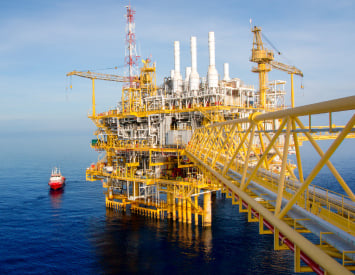From harvesting critical minerals to fueling energy needs, the deep sea holds vast promise, and engineers are the ones making it possible. Explore how civil, electrical, oil and gas, and mining experts are transforming underwater extraction into a safer, smarter frontier.
Underneath miles of crushing pressure and pitch-black water lies a treasure trove of resources: copper, cobalt, rare earth elements, oil, gas, and more. Extracting them safely and sustainably is one of the 21st century’s greatest engineering challenges, and one that demands cross-disciplinary expertise.
Civil, mechanical, and ocean experts
are designing submersible platforms, robotic miners, and pipelines that can function flawlessly at extreme depths. These environments feature temperatures near freezing, saltwater corrosion, high-pressure loads, and zero margin for error.
One standout innovation is the Subsea Production System, used in deep-water oil and gas extraction. People in the engineering fields integrate pumps, compressors, and wellheads into a compact, unmanned system that operates entirely underwater.
Shell’s Perdido platform in the Gulf of Mexico, for instance, uses such a system at depths exceeding 2,400 meters, an engineering marvel.
To stabilize equipment on the ocean floor, civil workers use remotely-deployed foundations built with geotechnical modeling to adapt to varying seafloor compositions. It’s a balancing act of physics, materials science, and marine knowledge, and those in the field are leading the charge.

Powering Operations with Smart Electrical Systems
Extracting underwater resources isn’t just about mechanical hardware, it requires immense, reliable, and adaptable power.
Electrical skills play a critical role in enabling continuous, safe operation of subsea systems, even thousands of meters below the surface.
High-voltage electrical transmission under the sea is challenging, especially where infrastructure is sparse. That’s where innovations like subsea “umbilicals” come in, multi-core cables that combine power, data, and hydraulic lines into one ruggedized conduit.
These cables must survive years of abrasion and salt exposure while ensuring consistent power delivery.
To reduce reliance on surface platforms, workers are also pioneering autonomous subsea power modules, often powered by underwater turbines or lithium-ion battery packs. These systems provide local energy to deep-sea robots and sensors, allowing for greater reach and fewer surface support vessels.
One recent success is Equinor’s Troll A platform, where electrical experts integrated smart sensors and AI-controlled systems that manage power loads based on real-time pressure and flow conditions.
This not only boosts efficiency, but also extends the operational life of subsea equipment.
Mining the Seafloor: New Frontier Technologies
Seafloor mining once sounded like science fiction. Now, it’s becoming a reality, thanks to the ingenuity of mining and mechanical talents. The ocean floor is rich in polymetallic nodules, lumps of critical materials like cobalt, manganese, and nickel, vital for EV batteries and electronics.
One pioneering project is spearheaded by The Metals Company. Formerly known as DeepGreen Metals, they are a Canadian deep-sea mining exploration firm headquartered in Vancouver, which developed robotic collectors that gently harvest nodules from the seabed with minimal disruption.
These machines are engineered to operate with soft-tread tracks and suction arms designed to avoid stirring up sediment plumes, which could harm marine ecosystems.
To transport materials to the surface, engineers designed riser systems, high-pressure vertical pipelines that lift slurry thousands of meters from the seafloor. These require precision flow control, corrosion-resistant materials, and real-time monitoring, all of which fall under the realm of mining and mechanical skills.
Electrical and software experts also play a part, developing autonomous control systems to guide these machines via satellite. The aim: mine smarter, not harder, and do it all with minimal human risk.
Supporting Infrastructure: Civil and Environmental Engineering
Beyond mining and drilling, experts are also developing the supporting infrastructure that makes deep-sea extraction possible and more sustainable.
Civil experts, for example, are responsible for designing underwater tunnels, seafloor habitats, and anchoring systems that can withstand massive forces and unpredictable conditions.
Take the Nord Stream subsea pipelines in the Baltic Sea. These were laid using sophisticated seabed modeling and civil-engineering techniques to avoid undersea landslides and tectonic fault zones. Workers also employed underwater drones to inspect, repair, and maintain infrastructure without exposing divers to dangerous depths.

In oil and gas, environmental and civil talents work together to design blowout preventers and redundant safety systems, like those used on BP’s Atlantis and Chevron’s Big Foot platforms. These systems help avoid disasters by automatically sealing a well if pressure surges unexpectedly.
Additionally, workers are incorporating eco-sensitive technologies, such as artificial reefs built from sustainable concrete to help restore habitats affected by underwater construction. It’s part of a growing effort to extract responsibly, balancing innovation with preservation.
Engineering the Future of the Ocean Frontier
As we look toward the future, the potential of underwater resource extraction is boundless. The next wave of engineering innovation could see us tapping into previously inaccessible energy sources and minerals with minimal environmental impact, revolutionizing industries from clean energy to technology.
In the future, civil talents might design self-sustaining underwater habitats for research or even human settlement, while electrical and mechanical engineers could develop entirely new materials to withstand the harshest deep-sea conditions.
The possibilities are endless, and the engineers of tomorrow will be the ones to unlock them, turning today’s ideas into the ocean frontiers of the future.
References
Deep-sea mining technology: the potential job market and challenges
Underwater construction Marvels and How do engineers make them

